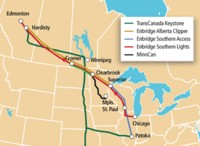US Issues Permit for Oil Sands Pipeline
 GLOBE-Net - The US State Department has issued a Presidential Permit to Enbridge Energy, Limited Partnership to enable construction of the Alberta Clipper pipeline for the transport of crude oil from the Canadian oil sands to US refineries.
GLOBE-Net - The US State Department has issued a Presidential Permit to Enbridge Energy, Limited Partnership to enable construction of the Alberta Clipper pipeline for the transport of crude oil from the Canadian oil sands to US refineries. The 1,000-mile/1,607-km pipeline will run from Hardisty, Alberta, Canada, to Superior, Wisconsin. Construction in the United States will consist of two components that would have independent utility: the Alberta Clipper Pipeline itself and the Southern Lights Diluent Pipeline. The 36-inch Alberta Clipper Pipeline will carry up to 450,000 barrels of oil sands crude per day-with ultimate capacity of up to 800,000 bpd available-from the Western Canadian Sedimentary Basin in Canada to refineries in the US.
In the US, the Alberta Clipper Pipeline will extend 326 miles from the US-Canadian border near Neche, North Dakota across northern Minnesota to an Enbridge terminal in Superior, Wisconsin.
The Southern Lights Diluent Project will consist of a new 20-inch pipeline extending 191 miles from Superior, Wisconsin to an Enbridge terminal in Clearbrook, Minnesota. In the US, these pipelines will be constructed at approximately the same time in the same right-of-way, and this right-of way would almost entirely be located along an existing Enbridge pipeline right-of-way.
Because the Alberta Clipper Project requires a crossing of the US-Canadian border, a Presidential Permit is required from the State Department for the project to proceed. Environmental groups had been urging Secretary of State Hillary Clinton to reject the permit based on the greenhouse gas and other environmental tolls taken by oil sands production.
Some opposition is predictable – from property owners who would lose land to right-of-way, and others concerned about wetlands and oil spills.
In a statement issued on the granting of the permit, the State Department said that it had found that the addition of crude oil pipeline capacity between Canada and the United States “will advance a number of strategic interests of the United States.”
“These included increasing the diversity of available supplies among the United States’ worldwide crude oil sources in a time of considerable political tension in other major oil producing countries and regions; shortening the transportation pathway for crude oil supplies; and increasing crude oil supplies from a major non-Organization of Petroleum Exporting Countries producer.
…The National Interest Determination took many factors into account, including greenhouse gas emissions. The administration believes the reduction of greenhouse gas emissions are best addressed through each country’s robust domestic policies and a strong international agreement.
…The United States will continue to reduce reliance on oil through conservation and energy efficiency measures, such as the recently increased Corporate Average Fuel Economy (CAFE) standards, as well as through the pursuit of comprehensive climate legislation and an ambitious global agreement on climate change to include substantial emission reductions for both the United States and Canada.”
The Department said that it environmentally reviewed the project in accordance with the National Environmental Policy Act (NEPA), which requires public disclosure of potential environmental impacts, identification of potential mitigation measures, and consideration of alternatives to avoid or minimize potential significant impacts.
The public scoping period formally concluded on 10 September 2007. The written and verbal comments received during the scoping process were used to prepare an Environmental Impact Statement (EIS). The Draft Environmental Impact Statement (DEIS) was published 5 December 2008. Public comments on the DEIS were accepted until 30 January 2009.
In December 2008 and January 2009, public comment meetings were held at 8 locations along the pipeline route to receive public comments on the DEIS. The written and verbal comments received during this process were used to prepare the Final Environmental Impact Statement (FEIS). The FEIS was submitted to the EPA on 5 June 2009.
Details on the project are available on the US Dept. of State Alberta Clipper Project website (including EIS)
You can return to the main Market News page, or press the Back button on your browser.


